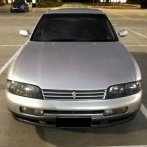Spool Type Head Drain
Announcements
-
Similar Content
-
Latest Posts
-
Well, in 2007 he must have been charging about $1800 an hour. He only looked at the car for 5 minutes. And another 4 to write the report wrong, and another minute to correct it. Mind you, this was for a car that was: Stock engine, fmic (hole in drivers guard), all alloy intake and custom air box, 3 inch turbo back exhaust, lowered, and a set of 17" Advans (255/40/17 rear and 235/45/17 front). It was nothing crazy. The blue slipper wanted the "hole in the guard" engineered. But that was because he got the shits that I wouldn't "relocate the battery from the boot, back to the factory position in the engine bay"... In an R33 GTST... Also for emissions, E85, and don't go wild on timing. It's amazing how the closer you get ignition timing towards max torque, the last couple of degrees really throw NOx counts right up. And for the huge increase in emissions, it's only a small increase in torque.
-
He'll be looking down and swearing about "the damn apprentice" for trying to convince Duncan to use percussive maintenance... 😛
-
I swear at my GKTech ones every time I have to take them apart and replace a spherical. But I wouldn't swap them for anything else. They absolutely slay every other option, at least in terms of how they actually work. You sure you don't want to live with bearings? I mean, they don't have "ball bearings". They are rod ends and sphericals throughout. Tough as nuts, even though I have found more than one way to wear them out.
-
From when I was looking at getting the 86 engineered for the turbo, the joint said to put in a few euro 5 or 6 cats, then tune the car on a nice clean E85 tune When I was looking at a turbo for the MX5, it was basically the same thing, a couple of cats and a nice clean tune Although, it will depend on the year of the Jeep IRT emmisions standards required, and what mods are done, especially if it has a newer engine installed that requires a higher Euro
-
Yeah - but it's not actually that easy. There are limits for HC, CO, NOx and particulates. Particulates shouldn't be a concern in any petrol engine unless trying to comply to the very latest Euro standard. But getting a tune right so that all the others stay within limits AT THE SAME TIME is not a trivial exercise. You couldn't possibly get it right by just guessing at the tuner's dyno, unless he had a 4 gas analyser up the pipe, which is not often the case these days. It used to be. Every decent shop that did "tune ups" (as opposed to tuning) would have a 4 gas analsyer. Perhaps there's still quite a few of them around these days. But most "tuners" are only watching O2 and power readings.
-






Recommended Posts
Create an account or sign in to comment
You need to be a member in order to leave a comment
Create an account
Sign up for a new account in our community. It's easy!
Register a new accountSign in
Already have an account? Sign in here.
Sign In Now